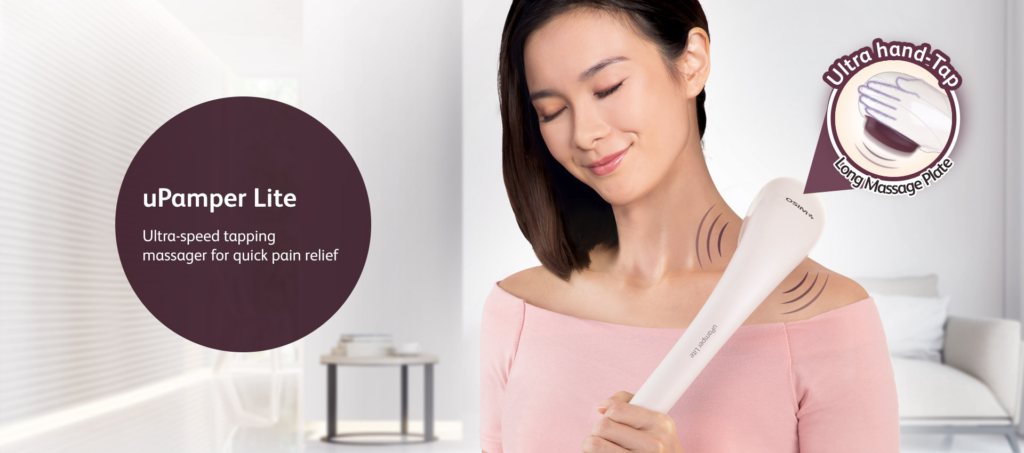A neck sprain is a common soft tissue injury that affects the ligaments in the neck, often resulting from sudden movements, awkward postures, or trauma. This injury can disrupt everyday tasks by causing pain, reduced mobility, and poor concentration.
Pain and stiffness typically occur around the nape of the neck and may radiate to the head and shoulders, sometimes accompanied by tension headaches or muscle spasms. Without appropriate care, symptoms may worsen, leading to reduced mobility or the development of chronic issues such as forward head syndrome.
This article outlines the causes of neck sprains, how to identify symptoms, and the most effective strategies for treatment. It also offers guidance on home-based care methods, including the use of a shoulder heating pad, neck strengthening exercises, and posture-correcting routines, as well as the benefits of using supportive massage tools to assist recovery.
What Is a Neck Sprain or Strain?
A neck sprain refers to the overstretching or tearing of ligaments in the cervical spine, usually caused by abrupt force or prolonged strain. Ligaments are fibrous tissues that connect bones and provide joint stability.
This condition should not be confused with a neck strain, which involves injury to muscles or tendons.
| Type of Injury | Affected Tissue | Common Cause |
| Sprain | Ligaments | Sudden movement, impact |
| Strain | Muscles/Tendons | Overuse, poor posture |
Both injuries can result in similar symptoms, but a sprain typically takes longer to heal due to ligament involvement.
Common Sensations and Discomforts
Individuals with a neck sprain often report:
- Persistent or sharp pain in the nape of neck
- Stiffness limiting the ability to rotate or tilt the head
- Muscle tightness across the head and shoulders
- Tenderness when pressing the affected area
- A feeling of pressure or pulling sensation in the neck
Associated Symptoms to Watch Out For
Additional symptoms linked to a neck sprain may include:
- Soreness at the base of skull
- Headaches caused by muscle tension or restricted blood flow
- Shoulder and upper back fatigue due to compensation
- Mild swelling or bruising (in more severe sprains)
These signs can indicate the degree of the injury and may help determine the need for medical intervention.
Who’s at Risk of Experiencing Neck Sprains?
Certain groups are more prone to developing neck sprains, including:
- Desk-based professionals with suboptimal workstation ergonomics
- People with underlying conditions, such as arthritis in the neck
- Those recovering from whiplash or minor vehicle collisions
- Athletes involved in sports with physical contact or sudden movements
- Individuals with forward head syndrome from prolonged screen use
Poor posture and a sedentary lifestyle can gradually weaken the supportive structures in the neck, increasing vulnerability to injury.
Diagnosis and Medical Support
Prompt and accurate diagnosis of a neck sprain is essential to ensure appropriate treatment and to rule out more serious injuries such as fractures or nerve compression. Medical professionals will assess the severity of the sprain and may recommend a combination of imaging, physical examination, and symptom review to determine the best course of action.
How Neck Sprains Are Diagnosed by Professionals
When diagnosing a neck sprain, healthcare providers typically begin with a thorough history of the incident and symptom onset. This is followed by a physical examination to assess mobility, tenderness, muscle strength, and neurological function.
In certain cases, additional diagnostic tools may be used:
- X-rays: To check for fractures or spinal misalignment
- MRI (Magnetic Resonance Imaging): Useful in visualising ligament damage and detecting soft tissue injuries
- CT scans: Sometimes used if complex bone involvement is suspected
These investigations help differentiate between a simple sprain and more severe cervical injuries that may require specialist care.
Treatment Options: From Clinical to Physical Therapy
Treatment for a neck sprain depends on the extent of the ligament damage. In most mild to moderate cases, conservative management is recommended.
Common treatment approaches include:
- Rest and immobilisation – Short-term use of a soft cervical collar may be advised to limit movement and allow ligaments to heal.
- Cold and heat therapy – Ice packs can reduce initial inflammation, while a shoulder heating pad is effective during the recovery phase to ease muscle stiffness.
- Pain relief medication – Non-steroidal anti-inflammatory drugs (NSAIDs) such as ibuprofen may be prescribed to manage pain and swelling.
- Physiotherapy – Once acute symptoms subside, gentle neck strengthening exercises and range-of-motion therapy may be introduced to restore function.
Severe sprains with instability or neurological involvement may require specialist referral and more advanced interventions.
At-Home Care and Exercises for Relief
Recovering from a neck sprain can often be managed effectively with consistent home care and guided movement. While rest is important in the early stages, prolonged inactivity may delay recovery. Gradual introduction of controlled exercises and therapeutic aids can significantly improve flexibility, reduce discomfort, and prevent long-term issues.
Can You Exercise with a Sprained Neck?
Light exercise is not only possible but often recommended as part of the recovery process, once the acute phase has passed and pain has subsided. However, it’s important to follow medical advice and avoid any movements that worsen symptoms.
Approved low-intensity movements include:
- Neck tilts (side-to-side and forward-backwards)
- Shoulder rolls to reduce upper back tension
- Gentle isometric neck resistance exercises
These neck injury exercises help maintain range of motion and support blood flow to the healing tissues. Strengthening the surrounding muscles, especially the upper trapezius and cervical spine stabilisers, contributes to long-term recovery and spinal alignment.
Should You Stretch a Strained Neck?

Yes, stretching can be beneficial, but it must be approached cautiously and progressively. Once inflammation has decreased, gentle trapezius stretching exercises and mobilisation can prevent stiffness and aid in rehabilitation.
Effective stretches include:
- Lateral neck stretch – Gently tilt the head to one side, holding for 15–20 seconds
- Upper trapezius stretch – Sit upright and pull the head slightly forward and across the body
- Levator scapulae stretch – Rotate the head slightly and look downward as if toward the armpit
Stretching should be done slowly, without bouncing or forcing the movement. Pain should not increase during these exercises. If in doubt, seek guidance from a physiotherapist.
Self-Care Tips to Soothe Neck Sprain at Home

A structured home routine can help accelerate healing and relieve ongoing symptoms.
Recommended home care measures:
- Apply ice packs during the first 48 hours to minimise swelling
- After two days, switch to heat therapy using a shoulder heating pad to ease muscle stiffness
- Maintain good posture when sitting and sleeping (use a neck-supportive pillow)
- Limit time spent on mobile devices to avoid forward head syndrome
- Take short breaks from sitting by standing and moving regularly
In addition to traditional methods, incorporating supportive devices may enhance comfort. Tools like OSIM’s uCozy 3D Neck & Shoulder Massager or the uPamper Lite Handheld Massager can help relieve localised tension when used in moderation and alongside stretching.

Recovery Timeline: How Long Does a Neck Sprain Take to Heal?
Healing time varies based on the severity of the sprain:
- Mild sprain: May resolve within 1–2 weeks
- Moderate sprain: May take 3–4 weeks
- Severe sprain: Could require 6 weeks or longer, particularly if ligament damage is extensive
Progress is typically gradual. Residual stiffness or discomfort may linger temporarily, but consistent care and rehabilitation can restore normal function without lasting effects.
How to Prevent Recurring Neck Strain and Sprain
Prevention is key to avoiding repeat injuries. Strengthening the neck and maintaining awareness of posture can significantly reduce risk.
Prevention strategies include:
- Practising proper lifting technique—avoid bending or twisting the neck
- Adjusting the desk and screen height to reduce forward head syndrome
- Performing regular neck strengthening exercises and posture drills
- Taking movement breaks during long periods of sitting
- Using ergonomic supports or massage tools such as the uJolly Sync Upper Body Massager to ease tension
Early intervention and lifestyle adjustments go a long way in protecting the cervical spine from future strain.
When to See a Doctor

While most cases of neck sprain respond well to self-care and conservative treatment, some situations require professional medical attention. Delaying assessment can lead to complications or mask more serious conditions.
Seek medical advice promptly if you experience:
- Persistent or worsening pain that does not improve after a few days of rest
- Numbness, tingling, or weakness in the arms or hands
- Severe headaches originating from the neck or base of the skull
- Difficulty maintaining balance or coordination
- Inability to turn or support the head without significant discomfort
- Symptoms following a traumatic event, such as a fall, sports collision, or car accident
These may indicate a more complex injury, such as nerve impingement, herniated disc, or fracture, and should be evaluated using appropriate imaging and neurological testing.
Managing a Neck Sprain Safely and Effectively
Effective recovery from a neck sprain requires a balance of early rest, gradual movement, and posture correction. Maintaining ergonomic awareness and addressing poor habits can reduce symptoms and help prevent future injury, particularly in individuals with forward head syndrome or arthritis in the neck.
As healing progresses, incorporating neck strengthening exercises and stretching of the trapezius muscles supports mobility and builds long-term resilience. Practical self-care methods—such as using a shoulder heating pad and adopting supportive sleeping and sitting positions—can further ease discomfort throughout the recovery process.
For those looking to improve their recovery and long-term neck health, OSIM offers a range of wellness solutions designed to support comfort, mobility, and muscular care through every stage of healing.




